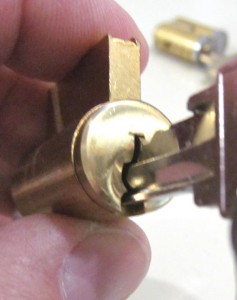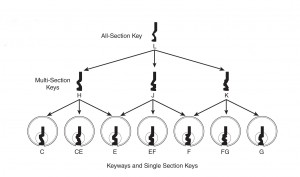 The keyway is the shape of the keyhole of the lock cylinder into which the user inserts the key. The keyway is designed to allow only keys of the correct shape to be inserted such that, when properly made, they will align the pin tumblers properly and operate the cylinder. If you view a key from the tip, you can see how the shape of the key corresponds to the shape of the keyway.
The keyway is the shape of the keyhole of the lock cylinder into which the user inserts the key. The keyway is designed to allow only keys of the correct shape to be inserted such that, when properly made, they will align the pin tumblers properly and operate the cylinder. If you view a key from the tip, you can see how the shape of the key corresponds to the shape of the keyway.
The theory behind the keyway is to let only certain kinds of keys in and keep all others out, and keyways do this with varying amounts of success. A variation on this idea is the “sectional” keyway system in which keys of slightly different keyways are allowed to “pass” into the cylinder keyway. See the diagram of the Schlage hierarchy of keyways below:
The keyways shown at the bottom of the chart are designed to fit in only one keyway. Unlike the keyways shown in the top two rows, actual locks have the keyways in the bottom row. The keyways shown in the second row could be called sub-master sectional keyways because keys cut on blanks of these keyways will each pass several of the keyways in the bottom row. Keys cut on the “L” keyway shown at the top of the chart will pass all of the keyways below it. This keyway is designed to be used only at the level of Master or Grand Master key.
Unfortunately, some key duplicators use the “L” keyway key blanks to cut keys of any sectional keyway they may currently not have in stock. This shoddy practice degrades the security of a master key section that depends on sectional keyways for security.
Restricted Key or Restricted Keyway?
Keys can be stamped with the words, “Do Not Duplicate” or “Property of [insert name of institution or government agency here],” and that may stop some honest people from getting the key copied. The term, “restricted key,” however, usually means factory restricted keyway, and a factory restricted keyway can effectively inhibit unauthorized key duplication.
How Does a Factory Control a Keyway?
The most effective way to control unauthorized key duplication is to make the key blanks as difficult to get as possible. Key blanks are like blank paper to a copier. Imagine copy paper protected by a patent owned by a paper mill. The only place to get the paper would be the paper mill. Thus, one of the ways security hardware manufacturers protect a keyway is to protect it by patent law. Part of that protection is aggressively pursuing anyone who violates the patent with lawsuits and other legal instruments to prevent patent infringement.
Another way factories protect keyways is to keep records of who is using what keyway and where. Many companies have restricted key programs – Schlage Primus, Kaba Peaks and Medeco are a few examples. Factories may keep signatures of end users on file. In this case, requests for restricted products must be accompanied by a document that is signed with the correct signature or the factory will not release the product.
Some restricted keys come with an ID card that authorizes the card holder to get keys made. This is less secure than key duplication that is controlled at the factory, but it is a step up from keys that anyone can get made at Home Depot.
Keyways and Key Bumping
In order to use a bump key to open a lock, the key bumper needs to have the right blank. You cannot bump a cylinder with a bump key that has the wrong keyway. It won’t go in. Therefore, having a lock that has a somewhat rare keyway is a very easy and inexpensive way to make unauthorized entry by key bumping difficult. Most of the people out there bumping locks open are not the brightest bulbs in the lighting fixture. Challenge them with a hard-to-identify keyway and they will most likely be defeated.

